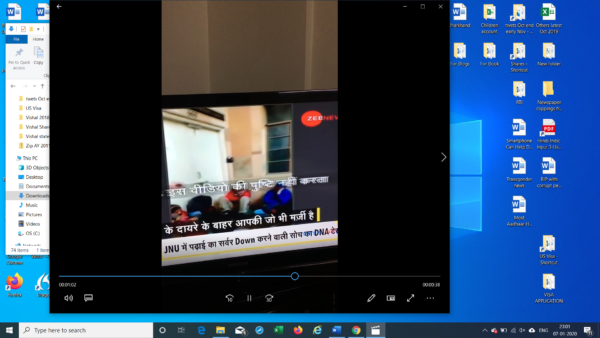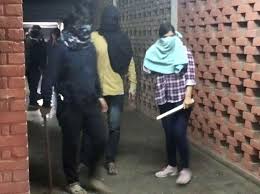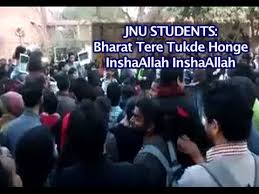
By now, the picture is quite clear. According to the videos released by various TV channels, with her face covered, Aisha Ghosh, an MPhil student and the President of the JNU (Jawaharlal Nehru University) Students Union, had opened the gate to let the masked men enter the campus.
To give an idea of how difficult it is for an outsider to enter the JNU campus, I would like to share what an ex-student, a well-known name in the University, told me on January 5 when the news of violence in JNU was coming on TV channels. I was sitting with him in his flat. We were trying to figure out how masked men entered the campus. He told me that a few days back, he wanted to enter the campus to meet a professor but had to wait at the gate for more than 30 minutes because the professor was not available for giving clearance for his entry.

MPhil student Geeta Kumari, a former president of the Students Union, was seen sitting near the server room to prevent online registration for the forthcoming semester examination by those who wanted to appear. The opposition to the students anxious to appear at the examination was part of the ongoing protests against hike in various fees charged from the JNU students.
Their motto seems to be “WE WIIL NEITHER STUDY NOR LET YOU STUDY.”

The masked men who had come from outside and might have included non-students started beating those who were eager to appear at the examination. The fight between two groups broke out on Sunday, January 5. 34 students and teacher were injured and rushed to the AIIMS. Soon members of the CPI and CPM and other political parties rushed to the hospital and started making acquisitions against their opponents.
In no time, pro-left students of several educational institutions came out in support of their fellow-travellers of JNU. The climax of the protest was a rally near Gateway of India in Mumbai where those protesting against CAA, NPR and NRC also joined. A girl was seen holding a placard “FREE KASHMIR”. She later told the media that when she saw it lying on the ground, she lifted and raised it thinking she was supporting demand for restoration of the Internet in Kashmir. (A very naïve explanation after a police complaint.) It is a matter of serious concern that those supporting attacks by goons in JNU were also supporting, at least by implication, protesters of CAA, NPR and NRC.
Traits of young students
For a long time, JNU has been a hotbed of leftist activities. Well, there is nothing wrong if one, whether a student or a non-student, has leftist leanings. (Only when one becomes mature and is stable to analyse, he/she realises that Karl Marx has misled millions of people into believing that he has prescribed a solution to the problem of poverty and inequality. I will write on the subject later.)
Similarly, there is nothing wrong if one has differences with governments policies and actions. What is wrong and harmful is use of violence to suppress the voice of those who have different opinion.
By nature, young students are critical of the government of the day. The leftist ideology is also very attractive to the students who see large-scale poverty and inequality in society. We have all passed through that stage. During the 1950s and early 1960s when I was a student and then a lecturer in Patna University, I was also a leftist, closely associated with the Student Federation (SF), the student wing of the CPI. For some time I was a member of the CPI and often very critical of the government. Our political inclinations became clearer and evident only at the post-graduate level. Several post-graduate classmates were leftists; there were very few supporters of the then Jana Sangh.
Another trait of the student community, especially of the leftists, is to organise protest marches on anything and everything if they feel that they need to protest. In July 1955, on my first day in the college, I saw a young man sitting in a rickshaw with a loudspeaker in his hand shouting “Sinha-Roy resolution murdabad.” The same day, the students went on strike in response to his call. (The background was a resolution adopted by Dr SK Sinha and Dr BC Roy, Chief Ministers of Bihar and West Bengal, respectively, for the merger of two states.) Later, I learnt that the young man was Syed Shahabuddin, a cardholder of the CPI and General Secretary of the SF, who later joined the IFS and after retirement re-entered politics with a new organisation – completely opposite to the communist ideology – Babri Masjid Action Committee.
Those days and for a long time thereafter, protests by students everywhere were peaceful. Protests becoming violent is a much later development.
The credit for introducing violence in the students’ protests goes to the communists. Karl Marx’s prophecy that ‘state will wither away’ did not come true but communists in India, outside Kerala, are definitely withering away. They have a serious problem, how to remain relevant in politics. Since Marxism is of no use now, they are always in search of any excuse to show that they do exist. Like all anti-Modi political parties, they also believe that as long as Modi is in power, they have no future. So, they support Kashmiri separatists, oppose the abolition of article 370, protest against CAA (citizenship Amendment Act 2019) and whatever comes handy.
Since the young students are easily attracted to the leftist ideology, communists have a special interest in student politics and encourage students to launch agitations against Modi and BJP. Since BJP has also become powerful, the clash between leftists and ABVP (Akhil Bharatiya Vidyarthi Parishad), the student wing of the BJP, is quite inevitable.
When communist parties take the initiative to lit the fire, other anti-Modi parties cannot ignore the heat. They see their future in joining hands with the communists for the ‘common cause’ i.e. create an anti-Modi atmosphere in the country.
We have seen several unfortunate results of their joint venture.
Major failure of the intelligence agencies
Whatever happened during the past few days in the JNU is a proof of major failure of the intelligence agencies.

For a long time, the JNU has been a hotbed of politics. Even if we ignore whatever happened in the distant past, since February 2016, the environment there has become a matter of serious concern. On February 9, 2016, despite a ban on organising protests inside the campus that day, University students joined the outsiders to protest against capital punishment to Afzal Guru (guilty of attack on Parliament building in 2001) and Maqbul Bhat, a Kashmiri separatist. They shouted slogans like “Afzal Guru, ham sharminda hain. Tere qatil jinda hain” ( Afzal Guru, we are ashamed that your ‘killers’ are alive, though the Supreme Court had awarded the capital punishment), “Bharat tere tukde honge, InshaAllah, InshaAllah” (God willing, India will disintegrate) and also, slogans for separation of Kashmir from India.
This type of protest that amounted to sedition was a serious matter. The choice of venue, the JNU, was even more serious. Why did the anti-Indian elements select the JNU for their protests? Obviously, because they got support from the leftists of the University who always enjoyed the backing of the left parties.
Since that day, the JNU should have been on the radar of the intelligence agencies. Even if they started keeping an eye on the activities inside the campus, they certainly became slack. Had they not become slack, they would have known that the agitation against fee hike that started on November 12 had not died. In December also, protestors stopped all students except those of the Linguistic Department, from appearing at exams.
Had they been keeping a close watch on what was going on, they would have known that masked men from outside were freely entering the JNU campus, a sure sign of preparation for violence. When students were bringing goons – may be non-students or goonda elements among the students – they were not doing so to get help in their studies. A timely alert by the intelligence agencies to the police would have avoided the violence that followed.
Major failure of the security guards and Vice-Chancellor.
As stated earlier, in the video clippings (including CCTV footage) publicly telecast by some TV channels, a girl student, now identified as Aisha Ghosh, with her face covered is seen letting the masked men inside the campus. The security guards are not visible in the video clippings. They must have been pushed aside.
Even if the security guards became helpless, it was their duty to immediately inform the higher authorities about the entry of the masked men. I have no idea whether they did so. Nor have I any idea whether any action has been taken against the security guards for dereliction of duty. Even if the security guards informed the higher authorities, apparently they did not take any action to evict those masked men, if necessary with the help of police.
Some students of the University have complained that the police did not come despite repeated calls. On the other hand, Delhi police claims that they got permission to enter the campus much after the violence had started. If the Vice-Chancellor delayed the grant of permission to the police, he is also responsible for the violence and deserves to be sacked.
We will know, hopefully, the full facts only when the report of the Delhi police officer investigating the case becomes public.
Delhi Police has filed FIR filed against Aisha Ghosh, Geeta Kumari and 18 others for allegedly vandalising the university property, a day before the mob attack. All of them were named by the university administration as being responsible for damaging the server room and hampering the online registration process for examination. Another FIR has been filed against unidentified people (i.e. masked goons) who carried out the violent mob attack resulting in serious injuries to 34 students and teachers.
The police should file FIRs also against those who brought the goons inside the campus for violence and Seetaram Yechury, Brinda Karat and D. Raja for directly or indirectly inciting and supporting the JNU students to indulge in violence at the cost of their studies.
Since JNU has taught a bitter lesson, before concluding would like to take this opportunity:
- To request the intelligence agencies keep a close watch on such students and any link between them and anti-national elements. Considering the fact that violent protests by university students are becoming a norm rather than an exception and student protests are being used by the anti-national elements, it is high time to do so.
- To ask student leaders, ‘do you want to become Kanhaiya Kumaar or Sitram Yechuries, liabilities on the society who waste your life on agitations without doing anything worthwhile? Do you know what Communists’ second most important Guru, Lenin, had told students? He had said: ‘Your first duty is to study. Your second duty is to study. Your third duty is to study.’
- To ask the JNU authorities, ‘how long you allow MPhil and PhD students to stay in the University hostel?’ The duration of the MPhil course is two years. In 2017 when Geeta Kumari was elected President of the Students Union, she was a second-year student of MPhil. In January 2020 also she is very much in the University. I have no idea whether she has completed the course and passed the examination but she is definitely preventing others from appearing at any examination. Aisha Ghosh is also an MPhil student.
- To request Prime Minister Modi to make a code of conduct for the student unions in colleges and universities. Since the total ban on students unions may not be feasible. unions should be completely separated from the political parties. Any association between a students union and any political party should make the union illegal. In the present atmosphere, this is the only course to preserve colleges and universities as educational institutions.
- To Delhi Police to arrest and interrogate those who brought the masked men inside the campus. Only they know those men.
- To request the peace-loving vast majority of People to boycott all those including film producers, actors, so called intellectuals and liberals, organisations and political parties who are supporting the rowdy leftist students of JNU and other educational institutions.
Devendra Narain










Leave a Reply